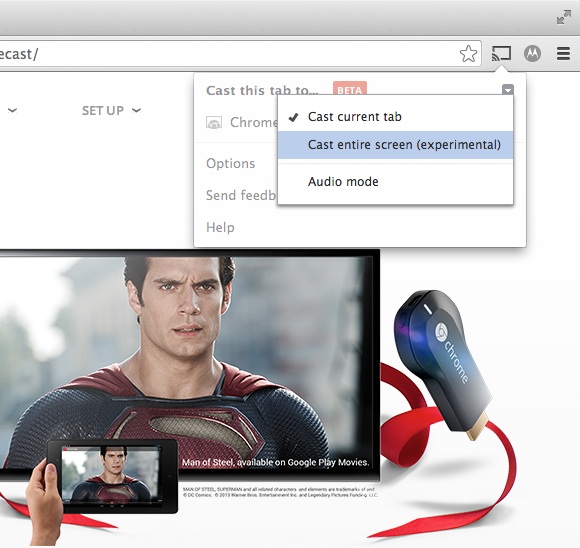Fellow tech enthusiast and DC neighbor Joel Ward continues his role as a ZNF contributor. Beyond Zatz Not Funny, Joel can be found at Joel Explains It All and @joelsef on Twitter.
When the Google Chromecast came out over the summer, one of the first things many of us wanted to use it for was phone, laptop, and tablet screen mirroring. Basically, something like Miracast (or WiDi). Alas, I was under the impression that Google’s initial implementation only allowed for mirroring of tabs in the Google Chrome browser…on a computer, not a tablet or phone. Of course there’s the baked in support for Netflix, YouTube, Hulu Plus, Pandora and a handful of other apps beyond the Chrome tab mirroring, but I wasn’t aware of official full screen sharing.

As it turns out, Google includes an experimental feature that allows full screen mirroring — only on desktop operating systems, via a Chrome browser plugin, and currently without audio. We can assume this experimental feature will eventually become an official feature, and hopefully include full audio, better performance, and Android support.
We have been playing with the Chromecast ($35) screen mirroring and comparing it to Miracast, and it seems to work in a very similar way, though with some differences.
Google Chromecast Screen Mirroring
- Works well to mirror the whole screen or a specific tab in the Chrome browser
- Can’t mirror as a second screen, or so it would seem
- Requires Chrome browser and works on Windows (not RT), Mac, ChromeOS
- Mirroring a tab instead of the whole screen works much better when viewing dynamic or video content
- Only works with desktop OS and browser at the moment (Android support is expected sooner or later)
- No audio transmission at the moment when whole screen mirroring, but does work when mirroring a single Chrome browser tab
- About .5 to 1 second lag time between desktop screen and wireless display
- Audio/video sync and frame rate isn’t always quite right, especially when doing full screen mirroring
- Less expensive option – $35 for the Chromecast and free Chrome browser
Miracast (or WiDi, Allcast, etc.)
- Works well to mirror the whole screen (duplicate) or extend the desktop as a second screen (at least in Windows)
- Second screen sharing is useful for things such as PowerPoint presentations where one screen can be the notes/control panel and the second screen is the full screen presentation
- Works on Windows 8.1 and Android 4.2+ phones and tablets. Mac has AirPlay mirroring, which is something different and not compatible
- Audio is supported and syncs with the wireless screen display (not the desktop screen)
- Does not require Chrome browser, but does require a device with Miracast/WiDi hardware and an OS that supports it as well
- About .5 to 1 second lagtime between desktop or tablet/phone screen and wireless display
- More expensive option – $30-$75 for the Miracast dongle (like this one from Best Buy that’s currently on sale for $20 instead of $70) or buying a new TV or projector, plus buying a new laptop, tablet, or phone that has Miracast support if you don’t already have one
All in all, both products work in similar ways, but each has its own benefits versus the other. Chromecast is the more economical choice, but Miracast has its benefits too, mainly maturity and features (at least at the moment) and built-in support with devices such as Smart TVs and projectors.
Sadly neither are compatible with each other, at least not at the moment. So you likely can use one or the other depending on your hardware—though it’s possible Windows 8.1 and Android 4.4+ will be able to support both at some point.
We’ll continue testing both options here at ZNF and will report back as we discover more!
I have a Dell XPS14 which supports WiDi. I picked up a NeoTV streaming box because it also supports WiDi for about $30 or $40 – much less than a dedicated WiDi box. I also have a Chromecast and have tried it with casting a Chrome tab – not yet the new whole screen browser and I can tell you that video quality from either of these options is pretty terrible if you are trying to watch something like hockey from NHL Gamecenter. Neither can come close to the quality of my $15 25 foot HDMI cable to run from my laptop to my TV.
Yep, wired connections are still the best, especially for watching video. Also if you don’t want the lag time that both Chromecast and Miracast “feature.”
This wireless display technology is probably best for presentations (PowerPoint!), photos, web browsing, and maybe document sharing (let’s edit that memo as a team!).
casting entire screen (experimental) feature has been in chromecast since its Day 1. Its not something that was added recently.
Hi Kartik, thanks for the correction!
We hadn’t investigated that feature until recently, so it was new to us. :-)
It seems full screen mirroring on Chromecast also can support audio now. Audio plays both on source device and on the TV (with a slight delay), but it works.
http://twitpic.com/dql1ps
I can’t stand having two screens/devices locked into the same content, and never understood the current fascination with mirroring for that reason.
I’d like to be able to cast a tab playing full screen Hulu to my Chromecast and then move something else to the forefront. So far this doesn’t seem to work, but I’m hoping they keep developing this feature.